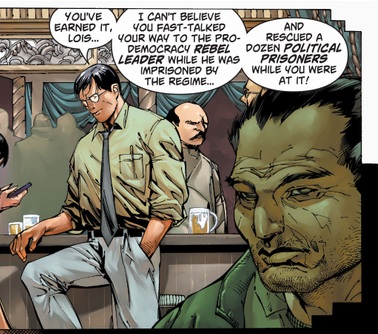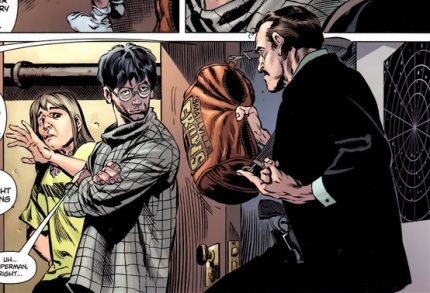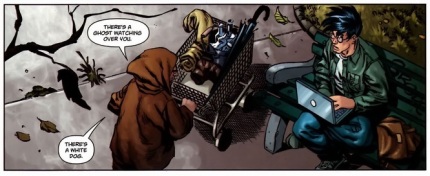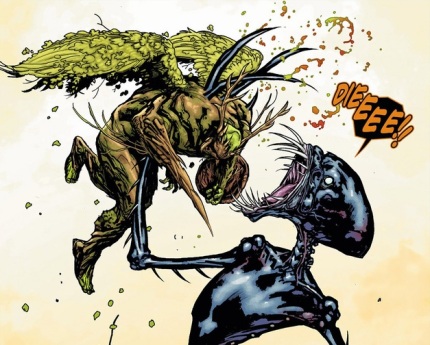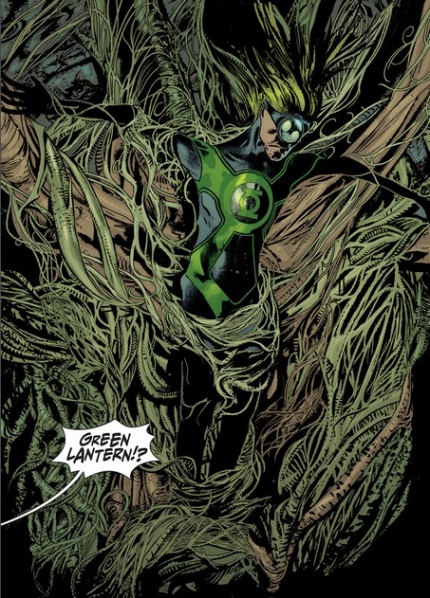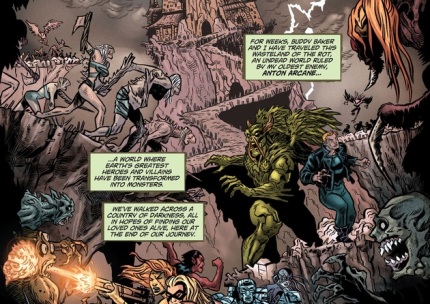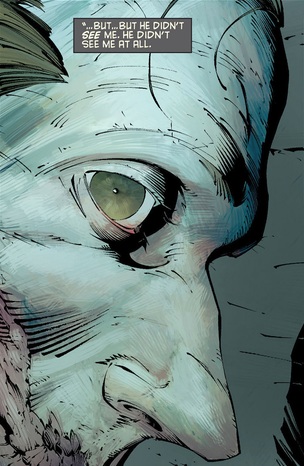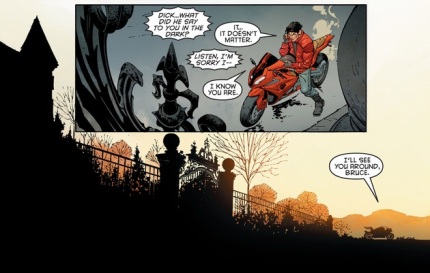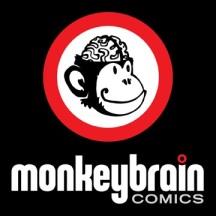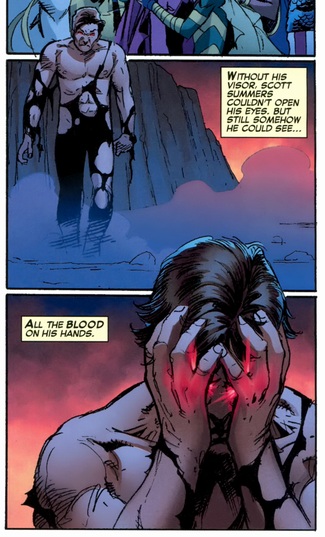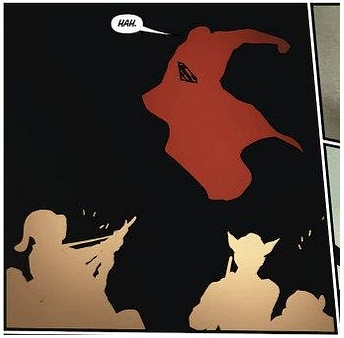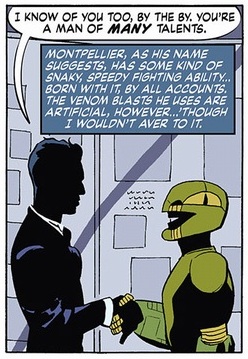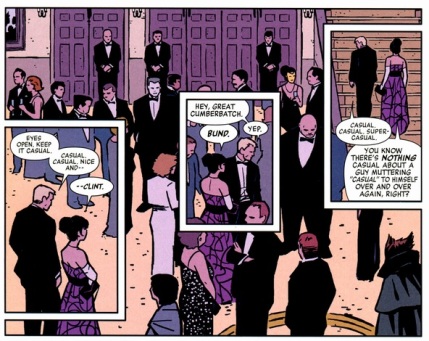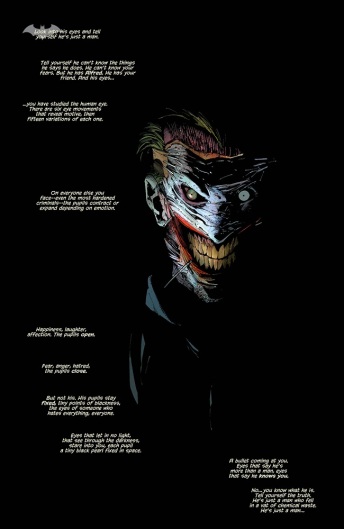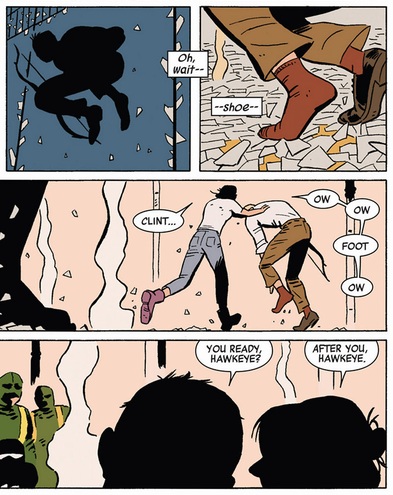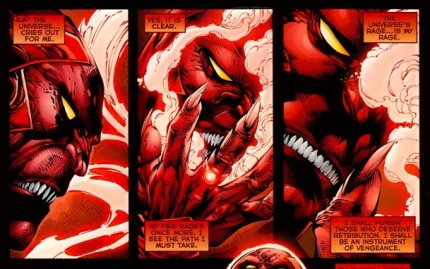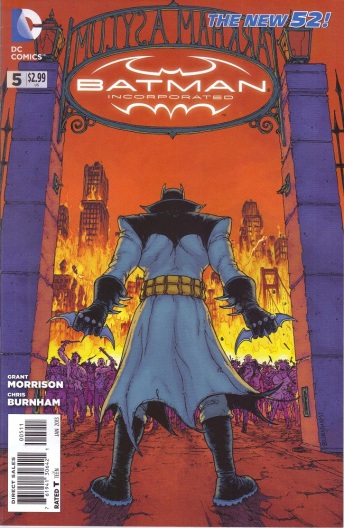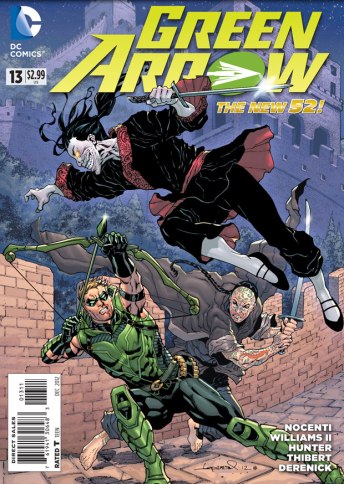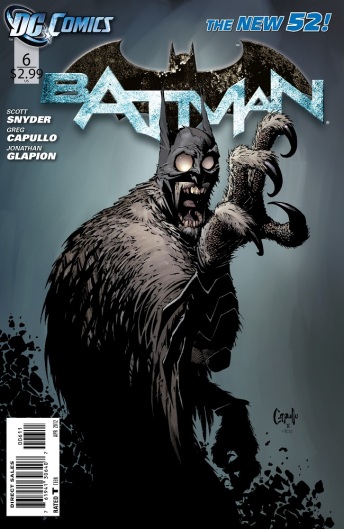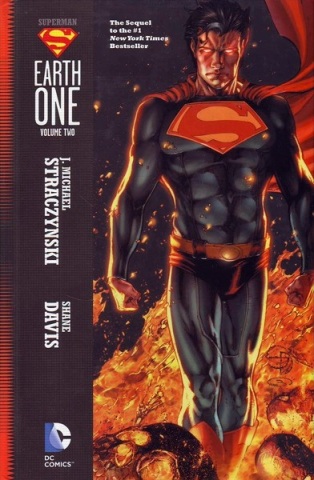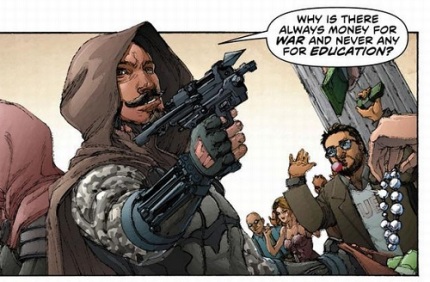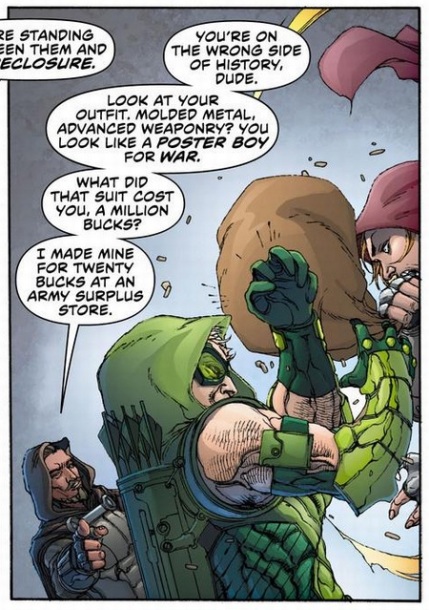Comics fans, be sure to check out a review of “Iron Man 3” on our sister site, Matinee Culture!
Action Comics 19 and DC upheaval
As a DC human (is that the opposite of a Marvel zombie?), I’m concerned about the very public creative upheaval that’s been going on at the company over the last year. As an outside observer, I don’t necessarily want to share my opinion about who is to blame for these issues – let’s face it, what with NDAs and conflicting rumors we’ll likely never know exactly what happened in most cases – but I do know that it’s certainly not in readers’ best interests to be subjected to the half-done, sometimes half-baked projects that come from a sudden shift in creative teams.
It was with that frustration that I purchased Action Comics #19, the first issue of Superman’s flagship title to boast the creative team of Andy Diggle on writing duties and Tony Daniel on pencils. As we now know, it’s also the last issue with the team, as Diggle quit the book before publication and Daniel will be scripting over Diggle’s plot for the next few issues. Going in, I viewed Action #19 as a curious artifact, a snapshot of what might have been had Diggle and DC been able to work out their differences.
We’ll never know now what might have been, but this first issue wasn’t particularly promising.
With a script bad enough that I’m half convinced that it too was mostly penned by Daniel (the man’s a competent artist, but his writing has never been to my taste), Lois and Clark are thrust into an Arab Spring-esque uprising in Qurac, DC’s fictional terrorist nation stand-in. Superman fights a few mechs ostensibly there to put down the pro-democracy uprising, and Lex Luthor puts in an appearance toward the end to reveal his hand in this latest plot to take down the Man of Steel.
Save for some good characterization of Luthor (I chuckled at his suspicion that his shrink might be a suicide risk), this was mostly non-compelling stuff, coupled with some truly horrible internal narrative and expository dialogue. Daniel’s art is competent as usual, and it’s elevated a bit by Tomeo Morey’s moody color palette (a distinct change from the more traditional tones of Grant Morrison’s Action run). This is nothing really to write home about, although there is some latent potential lurking within that will now never have the chance to be realized.
Ultimately, the most interesting thing about this comic is the rather cynical marketing plan around it. I’m not sure how far ahead of time DC prints its books, but the company’s main universe titles had preview art of issue 19 during the last week of March, and issue 19 itself teases upcoming issues as if Diggle and Daniel will be continuing on as originally planned. At the time of writing, DC’s own issue solicits still promote “the new creative team of writer Andy Diggle and artist Tony S. Daniel,” along with a few other promises that aren’t even touched on in the issue. Add that to a gatefold cover fake-out that has virtually nothing to do with the issue’s story and it’s hard not to feel like DC is attempting some sort of con on its readers.
The interiors of this book are not as described, and the ongoing story will not continue as described. Whoever’s fault this creative upheaval is, it’s DC’s responsibility to make it better.
—–
Have you liked Matinee Culture on Facebook yet?
Action Comics: Morrison masterpiece or Supermeh?
Some light spoilers for Grant Morrison’s Action Comics run follow, but you didn’t really need me to tell you that, did you?
When DC Comics’ New 52 relaunch began, many Grant Morrison fans – and presumably DC execs – were excited to see the writer’s name attached to Action Comics, doing a retelling of Superman’s earliest adventures. After all, Morrison obviously loves the character, and a well-received run on the Man of Steel’s early years could have made a nice companion to the critical favorite All-Star Superman.
Morrison’s now-completed Action run certainly isn’t a worthy successor (or predecessor, as the case may be) to the writer’s classic tale of the final year of Superman’s life, but it was a decent run all the same.
Oddly enough, its utter decentness is part of what makes it so occasionally frustrating. There are seeds of great stuff (and, individually, some great issues), but a steady stream of niggling annoyances keep it from rising to the level of a Morrison masterwork.
True to Morrison’s past work, his Action run is a chronology- and dimension-jumping wonderment, made up of a series of mini-arcs, standalone issues and an eight-issue opening story that is punctuated by a two-issue time traveler tale. Together, they eventually form a mostly-complete narrative that mostly comes together in Action issues 17 and 18, the latter of which is new this week.
Though Morrison is known for piling high concept upon high concept to create twisty narratives, the strength of his Action run (and of All-Star Superman, for that matter) lies in characterization, particularly in his outstanding knowledge of what makes Superman Superman and what makes Clark Kent Clark Kent. His young Superman may have been a brasher, sassier Kal-El than in recent years, but he was still Superman. He believed in people’s best impulses, and he was always looking out for the little guy. Similarly, Clark Kent retained his aw-shucks earnestness without being corny, and his interactions with everyone in the run, from the ugly landlady who-is-more-than-she-seems Mrs. Nyxly to his now-deceased parents to his journalistic peers, are characterized by humility, sincerity and kindness. Clark Kent and Superman work best when they are portrayed as the personification of the human ideal – and as an inspiration for us to aspire to that ideal – and Morrison nails those themes again and again.
The other element Morrison aces is excitement. Before the run began, the author gave interviews talking about how Superman needed to always be in motion, emphasizing the “Action” in Action Comics. The idea is delivered on consistently, as practically every issue is filled with frenetically paced fight scenes and thrilling moments of daring do. Even with a visually inconsistent art team (more on that in a moment), Superman consistently looks really cool and strong when he fights, particularly when he’s in his early T-shirt and jeans outfit (Sorry DC, I’m still not sold on the armored suit).
Now for the not so good. I’ve been harping on inconsistent art teams lately, but it does seem as if DC’s “must ship on time” policy is too much for some of the company’s pencilers. Ostensible series artist Rags Morales and co-penciler Brad Walker are both capable of fine work, but their styles are incredibly different, and dropping Walker’s art in when Morales can’t finish pages is jarring. Add that to Morales’s occasional inability to draw a consistent-looking human face, and you find yourself looking forward to the Gene Has, Travel Foremans, Andy Kuberts and Ben Olivers who come in for a guest issue.
“But how was the story?” you may be asking. Well, that depends on how much you like Morrison’s comics in general. The first 8 issue arc is very satisfying, and the core story of the whole run – that of an omni-temporal imp with a grudge who takes revenge against Superman in a disorienting way – is a solid concept. But there are a few problems that keep it from being all it could be.
First, the loose ends. Due to the time-twisty nature of the narrative, telling parts of the story out of sequence is certainly acceptable, but Morrison often makes the reader wait so long as to try patience. “Rewarding observant readers” is not always the same thing as “including a throwaway-but-confusing panel that will not be explained for 10 issues,” and while the back-up to issue 13 will make readers say “ohhh” when they remember issue 3, that doesn’t mean that the third issue is served by possessing what is quite literally an out-of-context panel. Morrison’s approach also sometimes made reading the book monthly something of a chore, as one issue might not make sense at all until the next month’s installment came out.
The loose ends idea also extends to some story elements that end up getting short shrift. Lex Luthor is a huge factor throughout the front eight, but his sudden appearance on the final page of issue 17 is rather out of nowhere, and his presence is both ill-explained and short-lived in 18. What happened with the “Icarus” side-plot, and why was Luthor involved in it? Apparently we’ll never know. The Captain Comet subplot seems very rushed, as well.
The other problem is the run’s conclusion, and here in particular is where your mileage will vary. While I’m certainly a Morrison fan, I tend to like his superhero work best when the central problem of his story can be solved in a concrete, rather than metaphorical, way. To use a recent example for fans of the author’s work on the Dark Knight Detective, Batman punching his way out of a coffin due to his years of training is much more satisfying to me than him not accepting Anti-Life by remembering “the first truth of Batman.” When Morrison ends an arc in a more metaphorical or spiritual way, he often counts on the frenzy of his imagination to carry the reader, spewing some half-sensical pop psychology and hoping that we can piece together the story enough in our heads to make up for what he’s left off the page.
The ending of the Action Comics run ends up somewhere between these two outcomes, as Superman solves his central problem in a physical way that requires a bit of nonsense to justify it. In the end, I liked the journey a bit more than the destination, but the journey was fun enough.
—–
Postscript 1: I did not mention the back-ups in the main text of the review, as they were primarily standalone or supplemental in nature. Suffice it to say that they started out corny, briefly became unbearable and then ended up good from issue 13 forward.
Postscript 2: Another element of the series that I didn’t touch on is how the comic functioned as part of The New 52, i.e. as a book that new readers could attach themselves to with little knowledge of previous continuity. Given that the method of defeating the villain is never explained outright but is known by those with previous Superman knowledge – not to mention the fact that the final issue features a brief return of Curt Swan’s lion Superman! – I’d say “not well,” but as I am not a new reader, I didn’t mind.
—–
Have you liked Matinee Culture on Facebook yet?
A Tale of Two Rotworlds
Warning: mild spoilers for Animal Man and Swamp Thing
In the months prior to the New 52, I read that Scott Snyder, a writer I’ve had good things to say about before, would be writing Swamp Thing after DC’s relaunch. I excitedly added the book to a list of New 52 titles I’d be picking up come September.
I then read that Jeff Lemire, a writer I knew little about, would be writing Animal Man, a character I knew maybe even less about. However, when I learned that Animal Man would be crossing over with Swamp Thing for an epic story called “Rotworld,” I readily picked up Lemire’s first issue as well.
Nineteen months and an overlong crossover later, Animal Man is the series I don’t regret picking up.
Neither of the series have been perfect, perhaps both hampered by a crossover that was planned out before the relaunch but didn’t actually begin until more than a year later. With a mandated 12 issues before the foretold Rot-related carnage could unfold, the preceding issues sometimes felt like a slow burn but often seemed like wheel-spinning.
Still, both series had very strong first issues, especially Swamp Thing. Before the relaunch, Yanick Paquette’s beautiful, hyper-detailed artwork was promised as the status quo for the book, and he delivers in a big way for Alec Holland’s New 52 debut. The reveal of the Rot monster and an early double-splash page portraying superheroes’ reactions to the sudden mass death of animals are particularly striking, setting a creepy tone and leaving the reader wanting more. Animal Man is similarly eerie, though Travel Foreman’s art is really showcased in later issues where the forces of the Rot and the Red take on more grotesque forms.
In the months that followed, Animal Man expanded its world while Swamp Thing alternated between classic Snyder creepiness and the establishment of a strange continuity that was unnecessarily confusing and certainly not inviting to a new reader.
While neither title was perfect, Animal Man had a great elevator pitch: C-list superhero balances work and family and fights to protect the world and his clan – all the while realizing that his own daughter is more powerful than he is.
Swamp Thing, on the other hand, ended up with an uninviting premise: Alec Holland, the man who Swamp Thing thought he was but ended up not being, comes back to life and then denies his destiny before actually becoming Swamp Thing, which he was always supposed to be from the beginning. The other half of the pitch – that Abigail Arcane has a tie to the Rot almost as strong as Alec has to the Green – is an interesting twist, but it’s just one plot thread that’s lost in a sea of overwrought narration and pointless continuity wrangling (the worst of which was found in the execrable 0 issue, which recontextualizes Swamp Thing’s origin story in a pointless and ultimately nonsensical way).
Also not great: the book’s decompression (I’m not a big fan of issue-long fight scenes, especially not in a series with such a cerebral lineage) and weird bursts of violence, like two cliffhangers involving Alec’s painful impalement within four issues.
When the crossover finally arrived, there were some complaints that it was too similar to Blackest Night, but I don’t actually think that’s fair. The “one year later” conceit was a legitimately surprising one, and the artists found some fun spins to put on the zombified characters (a particularly fun transformation was Bruce Wayne’s undead bat transmogrification). And, of course, last week we saw the true finales to Rotworld, with a couple of key character status quos changing and the threat of Anton Arcane being defeated. Both stories end on serviceable emotional notes, and though they do feel a bit manipulative, I didn’t mind too much (though Snyder’s ending could limit what future writers can do with the character).
In all, the linked sagas of these books’ initial stories could be remembered as mildly enjoyable comic book fare, done with a serviceable-but-not-particularly-memorable amount of craft. However, I haven’t yet mentioned the element that most clearly elevates Animal Man while sinking Swamp Thing: artistic consistency.
In this regard, Foreman and particularly Pugh are heroes. Both men were able to consistently crank out creepy, Red-and-Rot horrors week in and out, and Pugh’s expressive faces were an additional benefit to the Animal Man’s emotional core (as an additional way to keep Pugh’s consistency on the book, he handled the “future” elements on Rotworld while Timothy Green II handled the “present” sequences — a much better way to handle art changes than to switch between similar pages or issues).
Yanick Paquette is one of my favorite comics artists current working, but his intricate style is apparently too slow for a monthly book. In Batman Inc., this ended up being a blessing, as readers were eventually gifted with the excellent Chris Burnham, but Paquette’s inconsistency on Swamp Thing just led to him constantly trading duties with Marco Rudy.
Now don’t get me wrong; there’s nothing wrong with Rudy’s art. But a constantly shifting art team can dramatically hurt the flow of a comic story, and Rudy ended up helping on or straight-up filling in for 6 issues. Add that to three other issues penciled by guest artists (including Rotworld’s climax, which was penciled in a cartoony style so out-of-line with the series’s tone that the mind boggles), and you had a “featured artist” who could barely be counted on to show up for half of his issues.
I doubt Rotwold will be remembered as one for the ages, but it’s frustrating to think of the potential that was wasted by shifting art styles and an ill-advised start time of issue 13. In the end, Lemire was able to come up with an effective story by keeping the emotions grounded and the action consistently drawn, while Snyder was brought down by an overthought premise and a muddy visual direction. The combined series created something of a mish-mash, with every moment of brilliance seemingly followed by a maddening flaw.
I still like both writers, but I wish them better luck next time.
On Batman: Death of the Family and ending well
Warning: Spoilers for Death of the Family throughout.
In November, I wrote an article about the first issue of Scott Snyder’s “Death of the Family” arc, which reached its conclusion last week. In it, I questioned what I thought might be a developing trope of Snyder’s and a disturbing trend in Batman stories in general: the preponderance of people, both heroes and villains, who know Batman’s secret identity.
Since then, I have thought up a number of other complaints about DOTF: its somewhat contrived narrative twists, its strange expository fascination with ancient Batman continuity and its unfortunate crossover status (readers of the main series are never shown, for example, how Nightwing survives the reservoir explosion or how the Joker captured all of the Bat family). But after Batman #17, perhaps the best issue yet of Snyder’s run, none of those complaints really matter.
One reason is that my primary complaint about DOTF’s first issue is nullified. Joker does not know Batman’s identity and in fact has no desire to know. It’s not a unique choice, but it’s the best one for a character who so clearly enjoys the game. The other reason, however, is that Snyder’s ending is so strong and hits all the right narrative and emotional beats.
In so doing, it reveals another Snyder narrative trend, one I’m a little more comfortable identifying.
Snyder and penciler Greg Capullo, whose kinetic and evocative work continues to shine, hit so many great notes in Batman #17, from the interpretation of the Joker/Batman relationship to the recognition that the Caped Crusader may actually have been wrong to the quiet, simultaneous fraying of Bruce’s interpersonal relationships. But what really sold the issue for me was its sense of ambiguity, and it’s not the first time Snyder has dipped into that well.
Rather than ending the way many prognosticators believed it would, with a fat, definitive period (possible endings: Joker dies, a member of the Bat family dies, Batman decides to go “lone wolf” ‘90s style), Synder trails off with an ellipsis. In this case, it’s far more effective than a period could ever be.
First, there’s the matter of knowing the Joker/Batman’s civilian identities – or former identity in the case of the Clown Prince of Crime. While it’s implied in Joker’s case and outright stated in Batman’s case that the alter egos are still intact, Snyder wisely asserts the status quo while suggesting that the real truth may be different. We’re led to believe Batman is bluffing when he tells Joker he knows who he really is, but what if he wasn’t? Likewise, Bruce’s confidence that his brash visit to Arkham Asylum went unremembered by his nemesis seems irresponsible at best and fanciful at worst. In another story, this might strain credulity, but Snyder successfully uses the asylum checkup as an example of Batman’s hubris.
The second ambiguity is the handling of Joker’s demise. Rather than killing the villain outright or carting him away to Arkham at the end of the story, the more ambiguous fall down an underground cavern allows Snyder to tie a bow on the immediate narrative while allowing Joker to come back easily in the ongoing Batman meta-story. A concrete death would lessen DOTF’s impact once Joker inevitably returns from the grave; an Arkham lock-up makes the story more common. The dispatching of the Joker in DOTF carries an even bigger impact with the loss of the “mask face,” signifying a figurative death of this version of Batman’s greatest foe.
Finally, there’s the veracity of Joker’s claims and rightness of Batman’s actions. Snyder rightly avoids the hoary old chestnut of “Why doesn’t Batman kill Joker?” and instead focuses on a moment when Bruce saves his enemy from an accidental death. Why? “Everything that happens to you tonight happens by my hand.”
By saving Joker only to beat him with a crowbar, by leaving his family alone with a dangerous gas in order to settle a score and by being confident enough in his own knowledge to knowingly light his sidekicks on fire, Batman illustrates that the Joker may be right. Perhaps his obsession with his nemesis is more important to him than the people he cares about. Maybe it is a crucial breach of trust to not fill in the team on his extra-curricular Joker encounters. As the ending of DOTF shows, these questions will gnaw at Batman and his peers throughout upcoming issues.
This isn’t the first time Snyder has used ambiguity to good effect in a Batman tale. In “Court of the Owls,” the true existence of “Bruce Wayne’s evil brother” is left up for debate, and in “The Black Mirror,” a more subtle but far-reaching suggestion is made that the mutants of “The Dark Knight Returns” may be the product of James Gordon Jr.’s demented mind.
A good story leaves you thinking, both on its themes and its narrative. DOTF asks the reader if the thing we think we hate actually helps shape us, but it is wise enough to know that answers are often more effective if the reader answers them himself.
A story can cover a multitude of sins if it sticks the landing. “Death of the Family” did not commit a multitude of sins, but Snyder and his team stuck the landing anyway.
The 2012 Comics Year in Review (minus Saga)
Please note: First of all, while I do dip my toes into the Marvel and indie pools every now and then, budget and character interest generally point my interest toward DC. Also, I have a habit of not reading Brian K. Vaughan’s stuff until it’s collected into trade, so I haven’t read Saga yet.
It was an interesting year, if not always a great one, for comics. DC saw its first full year of the New 52 (is it still new, guys?), Marvel got a reboot/relaunch of its own with Marvel NOW!, Before Watchmen got going, Image launched Saga, the future of Dark Horse’s Star Wars comics became dubious, and more. What were the year’s highlights and lowlights? I’ll compile a few below.
Best webcomic: xkcd, Randall Munroe
Xkcd wasn’t always the funniest webcomic this year, but it was the most ambitious. In a format that seems designed to break the traditional comic strip or comic book format, many creators are content to simply reproduce digital versions of things that could be easily be published in printed form. Not so with Munroe, who mixed his jokes and nerd humor one-offs with graphs of the nation’s political history, odd physical representations of calendar references, and most famously a huge, scrollable world, the wonders of which I’m still discovering.
– Best strip: The aforementioned open world strip is hard to beat, as is this number on the jokier side of the spectrum
Best publishing initiative: Monkeybrain Comics
Chris Roberson got fired from/quit DC, but he’s making it look like a good thing with his rapidly-expanding business at Monkeybrain. Attracting big name creators to the small publisher might be the thing that ultimately pushes digital comics to the next level.
– Runner up: Marvel NOW!
Worst publishing initiative of the year: Avengers vs. X-Men
Just the press about this got tiresome, to say nothing of the interminable tie-ins, muddy plot and jerky behavior by all characters involved. Thankfully, some of the Marvel NOW! titles are salvaging the story.
Best pleasant surprise: Action Comics #0
In a sea of mostly disappointing number 0s from DC in September, Grant Morrison pulled out one of his best Superman stories yet, a simple tale of faith in the superheroic ideal. Ben Oliver provided a nice change of pace for the art.
Biggest disappointment: The Shade maxiseries
James Robinson’s Starman is awesome, The Shade is awesome, and many of the artists involved with the antihero’s most recent shot at stardom were awesome. Unfortunately, this series started slow (but good-looking) and ended slower, with too much exposition, not enough sense and three horribly boring issues drawn by Javier Pulido (which is odd, because his stuff is great in Hawkeye #4-5).
Best Cover: The Shade #4, by Tony Harris
Harris has been under fire lately for comments he made about female cosplayers, but his art is still unimpeachable in this old-timey Daily Mail-style cover.
– Runner up: Daredevil #10.1, by Marcos Martin and Manny Mederos
– Action Comics #0 variant, by Rags Morales
Worst (mainstream) Cover: Catwoman #0 (original), by Guillem March
Picking a worst cover of the year is an exercise in futility. For example, the actual worst cover I saw in a comic book shop this year was to Cavewoman: Natural Selection #2 (which I won’t bother linking to), but selecting it is defeatist because it’s trying to be exploitative and trashy. However, March, a respected artist working for a major publisher, should know better. His original Catwoman cover for DC’s Zero Month, in which Selina Kyle is seemingly all butt and breasts, was so quickly reviled by fans that the publisher pulled it before printing.
Best development for creators: The continued success of Image and smaller publishers
With The Walking Dead hitting 100 issues (and a crazy amount of sales), Image winning widespread acclaim and many other series getting their start this year, it’s good to know that many talented creators can find a home at Image or other smaller publishers if the Big Two aren’t to their liking. Marvel and DC have great characters, but sometimes creators want or need another outlet. Never has that outlet been more readily available.
Worst development for creators: DC editorial meddling
This is a year that has seen the likes of Chris Roberson and (temporarily) Gail Simone tossed off of books, John Rozum and George Perez going public about editorial meddling, and, in a less valued but still telling loss, Rob Liefeld engaging in a very public walkout from DC. Editors obviously have an important job to do (and, in Roberson’s case, there’s something to be said for not biting the hand that feeds you), but I want a DC Comics where the likes of Greg Rucka and Mark Waid are welcome again. Please DC, stop alienating top-flight talent.
Best single issue art: Batman Inc. #5, Chris Burnham
Burnham has been killing it on Batman Inc.’s art duties ever since he took over in 2011, but Batman Inc. #5 just might be his best. In a return to the grim future-world where Damian is Batman, Burnham peppers the pages with unsettling imagery, weird ideas, and in my personal favorite moment, a disturbing callback to the most famous scene in “The Killing Joke.” Props as well to Nathan Fairbairn, whose colors make the future-world feel properly post-apocalyptic.
– Runner up: Hawkeye #3, David Aja
– Batman and Robin #15, Patrick Gleason
– Batman #5, Greg Capullo
Worst single issue art: Green Lantern #6, Mike Choi
I probably wouldn’t be a big fan of Choi’s soft-focus, “ripped from the pages of a dungeon master book” art style on Green Lantern #6 no matter what, but what really nags at me is the jarring stylistic change from regular penciler Doug Mahnke. Changing an artist in the middle of a book’s storyline drives me crazy, especially when the differences in the art are so noticeable. What should have been an important, memorable issue of Green Lantern was marred by a mismatched art outing.
Best single issue writing: Hawkeye #2, by Matt Fraction
Hawkeye #3 gets all the attention for finally getting a car chase right in comics (and props to Fraction and Aja for doing so), but the banter between Kate and Clint in issue #2 is just perfect, to say nothing of the spot-on internal monologue.
Worst single issue writing: Phantom Stranger #0, Dan Didio
Didio is not typically a good writer, and his work on Phantom Stranger is no different than the norm (“Yeah, all my life I’ve been filled with an uncontrollable rage,” one character says to another at one point in this book, with not an ounce of sarcasm or self-awareness). From a boring plot to a rather nonsensical and badly-explained introduction of The Spectre, this book is amateur hour.
However, the worst part of the book is its premise: the revelation that The Phantom Stranger is, in fact, Judas Iscariot, clothed in Jesus’s robe and wearing as an unremovable necklace the 30 pieces of silver he received for his historic betrayal. Every time he does a good deed, the Phantom loses a silver piece, hoping to eventually gain redemption. Christian or no, this is in bad taste and a stupid idea.
Best series art: Greg Capullo, Batman
Aja’s Hawkeye and Burnham’s Batman Inc. were strong contenders for this slot (consider them my runner ups), but Capullo wins out for his consistency and for the fact that he’s the only one who’s been doing this all year. He also wins out for the above splash page, perhaps my favorite panel in a comic book in 2012.
Whether doing creepy character work or frenetic action scenes, Capullo infuses his drawings with emotion, creeping horror and kineticism. I’m a big Scott Snyder fan, but part of the reason he’s been so well-received in the comics world is his wealth of outstanding collaborators.
– Additional runner up: Stuart Immonen, All-New X-Men
Worst series art: Green Arrow, Dan Jurgens, Ray McCarthy, Ignacio Calero, Harvey Tolibao, Steve Kurth, Freddie Williams II
Can you guess why I didn’t like Ollie’s art this year? Once again, visual inconsistency was a huge factor in the wildly shifting tone of this series. Also, how does Green Lantern still have feet when his calves are so tiny?
Best series writing: Hawkeye, Matt Fraction
The two artists on Hawkeye so far have acquitted themselves wonderfully, but Fraction brings the charm with his writing. From Clint Barton’s quips to the intentionally bad translation jobs (“Some Spanish-sounding stuff!”) to the exceptional sound effects at play during “The Tape” (KGlassssss!), Fraction has created a hilarious and surprisingly compelling world for everyone’s go-to non-powered Avenger. In addition, his commitment to self-contained stories means that exciting stuff is going on every issue.
– Runner-up: Batman Inc., Grant Morrison
– Batman, Scott Snyder
Worst series writing (that I read): Red Lanterns, by Peter Milligan
There are some series that I avoid based on creative teams/bad word of mouth, so I would imagine Milligan didn’t do the actual worst this year. However, I checked out a few issues of “Red Lanterns” to see if I needed to know anything in regard to “Rise of the Third Army,” and boy, was this dire.
It’s probably not all Milligan’s fault. I can’t imagine it’s easy to write a book in which the only emotion characters feel is rage. Perhaps DC should have left them as supporting characters in the Green Lantern books.
Best single issue: Batman Inc. #5, Grant Morrison and Chris Burnham
This makes it two in a row for Morrison and Burnham, who last year cranked out Batman Inc. Vol. 1 #7, my favorite issue of 2011 (the Man-of-Bats issue). However, while 2011’s best issue was full of humor and weird political subtext, Batman Inc. #5 is all apocalyptic horror, creating images and feelings that will stick with you well after you reach the final page.
– Runner-up: Batman #5, Scott Snyder and Greg Capullo
– Hawkeye #2, Matt Fraction and David Aja
– Action Comics #0, Grant Morrison and Ben Oliver
Worst single issue: Green Arrow #13, Ann Nocenti and Freddie Williams II
Williams’s art has certainly been better, but the bulk of the blame for this mess of an issue falls on the shoulders of Nocenti, who decides to make seemingly every line of dialogue a horrible wisecrack. I’m not sure which is worse: anachronistic smart-aleck ghosts or Green Arrow’s internal monologue about how shooting off a Chinese man’s ponytail is an insult, followed by him shooting off a Chinese man’s ponytail and an onlooker saying, “That’s the biggest insult ever!”
Best comic/ogn: Batman, Scott Snyder and Greg Capullo (with a good fill-in from Becky Cloonan)
While a few other comics reached higher highs this year, no one impressed as consistently as Snyder and Capullo did. A consistent Top 5 title that earns its status, Batman is constant tension, psychoanalysis and action. With their two initial story arcs guaranteed to have lasting effects on the Batman world, Snyder and Capullo have exemplified everything good about bombastic superhero comics. Recognition should also be given to James Tynion IV and a host of artists who have provided solid work in the book’s backups.
Worst comic/ogn: Superman Earth One, Volume Two, J. Michael Straczynski and Shane Davis
This was a tossup between Earth One and Avengers vs. X-Men, but while Earth One was slightly more interesting, it earns its status as worst of the year by being completely tone deaf on why Superman works as a character. An angsty Superman is a bad Superman, but a Superman who encourages a violent coup and leaves a man to die in the Alaskan wilderness is no Superman at all.
Creator of the year: Ryan North
North was a creative force this year, continuing to churn out the consistently hilarious Dinosaur Comics, working on the critically lauded Adventure Time series and shattering Kickstarter records with his choosable adventure Hamlet story, “To Be Or Not To Be, That Is The Adventure.” Anyone unaware of North’s work should check him out posthaste, and it’s never been easier or more fun to do that than in 2012.
Be sure to check out Matinee Culture for the rest of Ryan’s pop culture bests and worsts!
——————-
Have you liked Matinee Culture and Capers! on Facebook yet?
How do you solve a problem like Green Arrow?
Comics have always had a problem leveraging box office or small-screen success into new readers. Part of that is built into the medium: do casual viewers want to engage in a new entertainment format, and, in the case of superheroes, do they want to follow the adventures of these kinds of characters more frequently than a few times a summer? Another issue is cross-promotion. Why isn’t the main Teen Titans book called “Young Justice” to capitalize on the TV show? Why doesn’t “The Dark Knight Rises” end with a post-credits admonition to pick up “Knightfall,” “No Man’s Land” and “The Dark Knight Returns”?
These are significant factors in the failure of comics to bank on their more marketable counterparts, but another big problem is the content of the comics themselves. As a comics fan, I’m not in favor of subjugating the contents of a comic to fit with its on-screen counterpart, but I do think that publishing a quality product is even more important when you’re dealing with a character with crossover potential.
Perhaps nowhere is this more painfully apparent right now than with Green Arrow. While I’ve generally been a bit more optimistic about The New 52 than many of comics’ harshest critics, DC Comics’ superhero line definitely has its share of stinkers, and Green Arrow is among the smelliest.
We’ll get to the specifics of why the series is bad in a moment, but it’s worth noting that DC apparently agrees with me. After more than a year of constantly shifting creative teams, lackluster stories, a general lack of direction and subpar sales, accomplished writer Jeff Lemire (Animal Man, Sweet Tooth) and unique penciler Andrea Sorrentino (I, Vampire) are being brought on to do a quasi-reboot of the title.
Lemire’s written a lot more comics than I have, so I don’t presume to give him advice. Still, here are a few things that have kept the current run on Green Arrow from being good – things I sincerely hope Lemire can rectify.
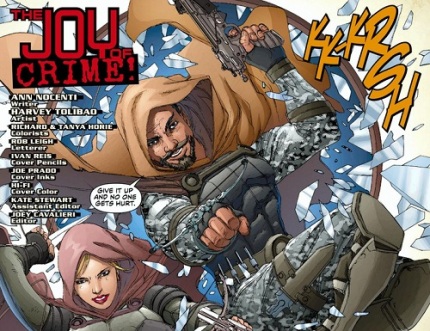
Here is the first of many panels from Green Arrow #11, by Ann Nocenti and Harvey Tolibao, in which a villainous character (who looks and acts much more like Green Arrow than Oliver himself does!) basically explains many of the New 52 book’s problems. This appears to be unintentional.
1. Impermanence
Lemire seems to have a bead on this problem already, talking in interviews about how he has multiple years of stories percolating in his head. I hope that’s true, because Oliver’s previous handlers have been rather flaky, passing him off through four different writers and even more pencilers in the last 15 issues. The resulting stories have been stop-and-go, hammily-written, and confusing (is Green Arrow’s identity a secret? If so, why does Oliver’s company lose money every time GA does something unpopular?).
While I’m all for strong single issues, Green Arrow might benefit most at this point from a longer storyline, one that allows readers to feel a narrative continuity that’s been sorely lacking from the book. As for Sorrentino, I hope that if he does require a fill-in artist, it can come in between major arcs, like what Greg Capullo is doing on Batman. I understand that DC wants to ship its titles on time, but constantly changing art pulls me out of a story, especially if it changes mid-issue.
2. Lack of social justice focus
Obviously, not all of Ollie’s adventures need to focus on freeing the downtrodden from their upper-crust, polluting, system-rigging oppressors, but one of the three things that made the pre-reboot Green Arrow unique (I’ll get to the other two in a minute) was his commitment to social justice. Not only did it inform how he behaved in his own stories – I can’t imagine another DC hero better suited to take in Mia Dearden, an HIV-positive girl forced into prostitution who later went on to be the new Speedy – but it affected so many of his character interactions as well. His rivalry with the conservative Hawkman, his begrudging acquaintance and eventual friendship with Hal Jordan, his distrust of more invasive superheroes like Batman – they all stem from his status as the DCU’s resident activist.
In his New 52 stories, Oliver has flirted with social justice issues, but he doesn’t appear to be too interested in them on a personal level. Sure, he’ll fight a man who is creating a “dead zone” in the frozen north or grapple with a psychiatrist who turns patients into robots, but every superhero would do those things, and Ollie does them with no more gusto than any C-list superhero would. Fighting for the disadvantaged used to be one of his defining personality traits, and while I understand his writers’ desire to take him in a new direction, they haven’t given him any discernible personality traits to make up for the ones he’s lost. He just hops around Seattle making lame wisecracks.
3. What about Robin Hood?
This ties back into point two. Besides social justice, the other two pre-reboot defining factors of Oliver Queen were his age (a gruff early forties, or at least that’s how I always interpreted it) and his similarities to Robin Hood. I know The New 52 required all of its heroes to be de-aged, and I’m not advocating for a simple return to the old Ollie. However, in its rush to remake Green Arrow in the image of Smallville, they dropped his most compelling hook: modern day Robin Hood.
With the success of franchises like The Hunger Games and The Avengers, archers seem very hot these days, but Katniss and the cinematic Hawkeye aren’t popular just because they shoot arrows. Instead, they’re compelling because of their personalities: a plucky survivor and a strong and silent iceman. Oliver’s status as a modern day myth has a number of storytelling possibilities built into its premise, from a 99 percent crusader to a rapscallion adventurer, but from his costume on down, DC has jettisoned those ideas.
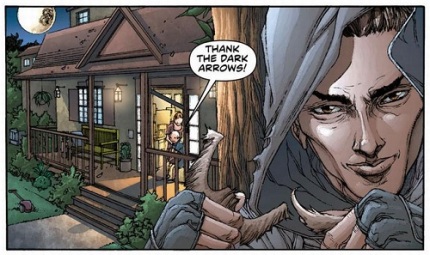
And, in the Dark Arrow’s last appearance in the book, he is shown taking off fake facial hair, aka the perfect compromise for Oliver retaining his iconic look while still being the clean-shaven pretty boy DC apparently wants him to be!
Oddly enough, the adaptation of Green Arrow that’s doing most service to the character these days is the one seen weekly on Arrow. Sure, the show can do disservice to characters from the comics and be rather silly at times – it is on the CW, after all – but the story of Oliver Queen righting the wrongs of his billionaire father’s former business associates is a compelling setup, one that gives the show a narrative trajectory while generating a real “rob the rich, feed the poor” vibe severely lacking in the comic. Similarly, his costume and arrows are far better than those of the comics Oliver Queen, who wears body armor, ugly ski goggles and rarely uses his hood. The TV show Oliver still gets high tech on a regular basis (he recently used a trick arrow to hack into a man’s bank account), but his leather outfit manages to convey urban warrior and roguish everyman at the same time.
So please, Jeff Lemire, give me a version of my Oliver back. Give me a hero who may be younger and smarter, but who still cares about the little guy and has some of that Robin Hood flair.
Give me someone interesting.
———————-
Have you liked Capers and Matinee Culture on Facebook yet?
DC’s New 30, Part 3
We’ve now come to the final part of the DC’s New 30, in which I imagine a smaller but yet financially viable DC line. Here is where I discuss the need for this change, and here’s the first half of my “redesign.”
On to the rest of the list.
Other teams
Speaking previously of Teen Titans and Worlds’ Finest, keep both of them (although if the Young Justice cartoon continues, rename the Team Titans book). Both of the books fill important niches. However, Teen Titans in particular could benefit from some changes.
While the line-up does have a few nods toward diversity in Bunker and Solstice, you could get more. Pull Skitter and either Superboy or Red Robin off the team and replace them with the new Blue Beetle and Static, and throw the new Aqualad in for good measure. I have no love for the rebooted Wonder Girl either, so I would suggest yanking her and replacing her with Stephanie Brown, but I know no one’s going to go for that.
Suicide Squad is definitely a concept that can work from a narrative standpoint, but that book is so bad right now that you’d need a complete overhaul to make it something that will both sell and be good. My suggestion? Keep it, but bring in a big writer to boost sales and make it more about character interaction and less about T+A and gratuitous violence.
Other books
This leaves with eight titles – two more slots than the six that were selling above 30K: Animal Man, Aquaman, The Flash, Phantom Stranger, Swamp Thing and Wonder Woman. Aquaman, Flash and Wonder Woman should all stay for name recognition, and Swamp Thing is typically a showcase for both writers and artists, so keep that too. Animal Man’s a maybe, but Phantom Stranger is still coming down from its debut numbers, and at 30,000 by its second issue, I think we can jettison this one.
Let’s look at our demographics now. While as a reader I care most about the creative output, demos are important to making groups feel included and to reaching the broadest base of consumers.
We have four to six female-led books, plus (under my book scheme) at least four group books with multiple female characters: JLA, JL Dark, Titans and GL Corps. Let’s add more women to Justice League, Earth 2, Suicide Squad and my theoretical Batman Inc. and Lantern.
We have one GLBT-starring book, plus Earth 2 (Alan Scott), Teen Titans (Bunker), although those numbers could be boosted by the return of some of Gail Simone’s Secret Six and Birds of Prey characters. We also have a few team books with people of color (JL, but no individual ongoings if you assume that Hal Jordan will eventually return to his starring status in Green Lantern. In fact, right now in the New 52 there are only three that I can think of, although the next wave will cut Blue Beetle and add Vibe and Katana.
That’s a problem, for my list and for DC in general. The company has been trying on this front, publishing the likes of Batwing, Firestorm, Blue Beetle, Static Shock, Mr. Terrific, OMAC and (I guess) Voodoo to little success.
It would be easy at this point to just slot in four people of color into the last spots – say Cyborg, Steel, Katana and The Atom – but we have to keep in mind the other important demographic element: book genre. Using DC’s own classifications, I’d say we have eight Batman books, seven Justice League books (which includes unclassified solo ongoings), four Superman books, three Green Lantern books, two Dark books, one Edge book and one Young Justice book.
These classifications are not, strictly speaking, exclusive (for example, could a Superboy and Supergirl title also fit under Young Justice? Is Wonder Woman more of a Dark or Edge title these days than anything else?) but it’s a good guide. We don’t want to end up with a homogenized DCU, from a representation or storytelling perspective.
It’s a little Batmanny, but I’d give one slot to Katana. With her history in the Outsiders, she can take on some weirder threats and give this book that “The Edge” vibe it needs. Cyborg could also face some weirder, tech-based threats (he should have his own series by now, really), but make fellow tech-based heroes Hardware, Steel and whatever Natasha Irons is calling herself these days into supporting characters. Call it “Cyborg and the Men of Steel.” The Atom is an obvious possibility, but Ryan Choi’s last book was cancelled after low sales (11,000 for the last issue in 2008). Float this one out to see how it does, and replace it with something else if it underperforms.
The last slot, I think, needs to go to Green Arrow in order to synergize with the TV show, but only if the CW starts actively promoting the comic and if the comic stops being insufferably bland. Otherwise, yank it and make sure Ollie gets some love in JLA.
I don’t claim to be an expert, and this has been more of a fun experiment than anything else. If I was going to actually pick 30 titles I’d want to see published, my list would be very different, but I think this could be something the company could really make work (likely with several modifications). What do you think? Am I crazy? If you had to knock DC’s ongoing superhero titles down to 30, what would those 30 be?
Here’s my final list.
BATMAN:
Batgirl
Batman
Batman Inc. (team-up book for various Batman Inc. affiliates)
Batman: The Dark Knight
Batwoman
Detective Comics
Nightwing
Robins (showcases multiple Robins)
GREEN LANTERN:
Green Lantern
Green Lantern Corps
Lanterns (overarching Rainbow Corps book, possibly starring Kyle Rayner)
JUSTICE LEAGUE:
Earth 2 (perhaps change this to Justice Society or Justice Society of America)
Justice League
Justice League of America
Justice League Dark
SUPERMAN:
Action Comics
Man of Steel
Superman
Superman Family (Superboy and Supergirl book, with Krypto, Jimmy, Lois, etc. thrown in)
OTHER INDIVIDUAL BOOKS:
The Atom
Aquaman
Cyborg and The Men of Steel
Flash
Green Arrow
Katana
Wonder Woman
OTHER TEAM-UP BOOKS:
Suicide Squad (retooled)
Teen Titans (retooled)
Worlds’ Finest
DC’s New 30, Part 2
Here’s the beginning of my list of possible changes that could be made to DC’s main superhero lineup in order to cut it down to 30 books. Part one, in which I discuss the benefits of the change, can be found here.
Batman:
Here’s one thing we’re going to have to accept: DC knows that Batman sells books, and the company would be foolish not to take advantage of that. Let’s give DC eight Batbooks, about a quarter of the line.
Which eight? Well, you need to keep Batman and Detective, obviously, and let’s assume that Batman Inc. will come to a close after Grant Morrison finishes his run. Though Batman: The Dark Knight is a superfluous offering, its existence is one of the few smart synergistic things the publisher has done in a while, so we’ll keep it for its movie recognition.
Batgirl and Nightwing are important properties, so let’s keep those as well. That leaves Batman and Robin, Batwoman, Catwoman, Red Hood and The Outlaws and Talon as unaccounted for 30K+ sellers.
At this point, we have more than enough Batman-starring titles, so let’s can B&R and replace it with a Robin title – or better yet, “Robins,” which could showcase all of Batman’s current and former bird-themed sidekicks. Though the four remaining titles are all good ideas in theory, Catwoman and Red Hood have been pretty much a mess since the reboot, so let’s drop those.
Now, I’m pained. I like both Talon and Batwoman, and even more than the titles themselves I like the idea of them (both spotlighting unique, newer characters). However, if I don’t cancel one or the other, we won’t have a Gotham team book.
My solution is to cancel Talon and to bring back (surprise!) Batman Inc. Once Morrison’s run ends, the book would focus instead on other people involved in Batman Inc. or involved with assisting Batman. I’m thinking Talon, Batwing, Man-of-Bats, El Gaucho, etc. Of course, this is contingent on what happens at the end of Morrison’s run, as well as where James Tynion takes the Talon title.
An alternate solution? I could keep the eight Batman titles and also include Birds of Prey, which was below the 30K cutoff but which could likely be a good seller with the right character makeup/creative team. Let’s set it in Gotham but make it further removed from rest of the Batbooks by not featuring Bruce very much if at all and by not including any Batpeople currently appearing in their own books. Let’s say Black Canary, Katana, Starling, and maybe Huntress, Renee Montoya, Poison Ivy, Starfire or Catwoman.
Eight titles down, 22 to go.
Green Lantern:
Honestly, DC would be dumb not to ride Green Lantern’s wave of popularity for as long as it can (translation: as long as Geoff Johns continues to write the main GL book), so let’s keep GL and GL Corps, and let’s replace New Guardians and the horrendous Red Lanterns with a more inclusive Lantern title that can encompass the overarching Rainbow Corps story. I’m thinking of something like a Star Wars Expanded Universe situation for the Green Lantern world. As a possible option, keep New Guardians if you want Kyle to headline a book.
Justice League/Justice Society:
Justice League is a rough book at this point, but it sells like gangbusters, so keep it (but diversify the lineup – let’s get Ryan Choi back). Likewise, Justice League of America will likely sell well, and Earth 2 is doing so now, so keep those. Justice League Dark is also holding up surprisingly well, so keep it to showcase the universe’s weirder characters (and use it as a repository for characters with cancelled titles, like Resurrection Man or Frankenstein).
Superman:
You’ve got to keep Action and Superman, and presuming that the upcoming Scott Snyder/Jim Lee book is going to be called “Man of Steel,” you’ll probably want that one for the synergy as well (if not, then just get that duo to take over the Superman ongoing). I would also argue that a Superman Family-style book could be a big seller, bringing lovers of Superboy and Supergirl into the same fold, so we’ll go with that too. Barring that, you could have both of them in individual books if the market could support it, or you could give them prominent roles in team books (Superboy in Teen Titans, Supergirl in Worlds’ Finest?).
On Friday, we’ll finish out the list with a few more nebulous categories.
———-
Have you liked Matinee Culture on Facebook yet?
DC’s New 30, Part 1
I read what I can.
I suspect that’s the way it is with a lot of comic book fans. They love the medium, but time and financial constraints force them to pick and choose from a glut of books which ones they’d most like to read.
As a lower middle class DC fan currently between jobs who does a lot of trade reading from the library and reading of current comics via other means, I snag approximately five DC books a month. Most of that’s because of the money involved in funding my habit, but the overwhelming volume of available DC titles is also a big factor.
I’ve been thinking about this a lot in the last few days, due in no small part to this Tilting at Windmills article (which itself samples a The Beat post) about comic book sales at The Big Two.
In the TAW article, comics retailer Brian Hibbs posits that most books from Marvel and DC that sell fewer than 30,000 copies are forcing comic book retailers to try to accurately stock issues that sell fewer than 10 copies per store. Such a scenario rarely makes money for the retailers, and it can’t make too much money for DC and Marvel, at least not compared to bigger selling titles.
Now, I doubt the situation is as simple from the publishing side as it is from the retailer side. For one thing, DC and Marvel are jockeying for position (even if they claim they’re not), and for one publisher to severely reduce its number of published titles would seem like a statement of defeat to many of the less savvy.
There’s also the matter that Hibbs brings up of how DC and Marvel shouldn’t have any “borderline books.” That’s almost certainly something that The Big Two would take issue with, as you have to account for kiddie comics, imprints and non-event miniseries, which typically sell lower than ongoing superhero books do. The publishers would also probably argue for the merits of publishing a low selling series to help “expose” characters they believe will become more profitable down the line, something that very well could be the case for DC’s upcoming Katana ongoing. Katana certainly has a following, but DC is right to believe that she could become much bigger.
That being said, another factor in why there are so many low-selling books from The Big Two is surely one of quantity. If DC only published 20 ongoing superhero titles instead of 52, there’s no chance that Superboy would be clocking in at under 30K.
I submit that if you got rid of the titles that sell under 30K, you would not lose the thousands of readers who read the lower-selling titles. Some might flee, but I think more of them would begin reading the titles you kept around, particularly if you do something to draw in many different kinds of readers. This would lessen the headache for retailers and presumably cut costs for the publishers as well, as long as they could keep a comparable level of readers. Sales would be boosted across the line.
There’s also another side effect of book reduction that I think hasn’t been discussed: accessibility. I know from years of trying unsuccessfully to get people into comics that the medium can be a confusing labyrinth for the uninitiated. With 52 ongoing superhero titles at DC, do you pick and choose the books you think will give you the best overall picture of the universe, or do you focus on self-contained titles? Which Batman book has the best Batman for you?
It’s arguably worse over at Marvel, which is starting its Marvel NOW! soft reboot with enough Avengers and X-Men titles and mashups to make your head spin (Uncanny Avengers, A+X, plus several other titles containing “Uncanny,” “Avengers,” “X+word” and so on).
You know what would guarantee my purchase of more titles? Fewer titles overall. If DC cut its mainline superhero titles to 10 books a month at three bucks a pop, I would buy every book, every month. I suspect many people would do the same. If there was a sense that you could get your brain around a superhero universe without spending $150+ a month, people would be lining up to do so.
OK, now let’s take a look at the numbers and enter the fantasy world in which I make DC’s policy. In October, of the 35 DC titles that made more than 30,000 orders, 28 were mainline New 52 titles (FYI, the other seven were annuals and Before Watchmen installments). Of those, 11 (!) were Batman-related titles, four were Lantern titles, three were Justice League/Justice Society titles, two were other teams, two were Superman, and six were other individual titles. How can we take DC’s best sellers and turn them into a line that can take advantage of what should be a diverse readership?
Well, first of all, let’s take that number of 28 and bump it up to 30. With fewer books, readers will theoretically bump up sales numbers for the remaining titles. The next two highest-selling New 52 books in October were Supergirl and Suicide Squad. On Monday, we’ll start looking at the demos we want to hit.
————–
Have you liked Matinee Culture on Facebook yet?
